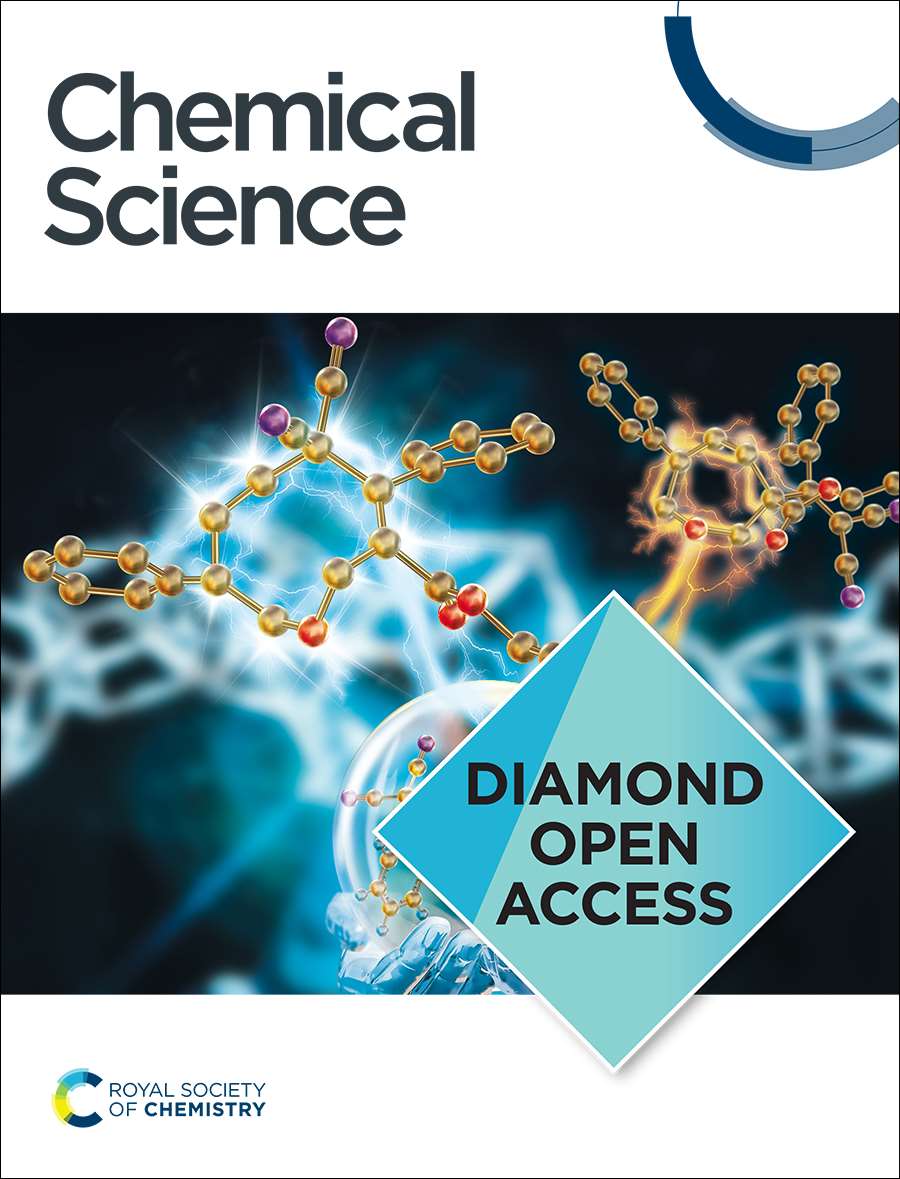动态硼酸-二醇络合对光驱动分子马达旋转方向的外部门控
IF 7.6
1区 化学
Q1 CHEMISTRY, MULTIDISCIPLINARY
引用次数: 0
摘要
手性立体拥挤烯烃是人工光驱动旋转分子马达(LRMMs)的潜在候选物,它通过一系列光化学和热异构化过程围绕CC键进行360°的单向旋转。然而,大多数报道的lrmm采用固有手性(即手性中心和光响应单元的集成),这阻碍了通过手性开关有效地控制其旋转方向。在此,我们报道了一种新的立体过度拥挤的烯烃,配备了硼酸受体,用于与手性邻二醇进行动态共价键,使其能够作为外源性手性基LRMM。动态硼酸-手性二醇B-O键不仅实现了烯烃主链的外在手性,诱导了烯烃主链的螺旋偏好,而且通过二醇交换实现了手性转换,逆转了其旋转方向。这项工作表明,外部手性实现的动态共价键是设计方向可切换lrmm的有效策略,为更复杂的分子马达在复杂(生物)环境中的应用铺平了道路。本文章由计算机程序翻译,如有差异,请以英文原文为准。

Extrinsic gating of the rotary direction of a light-driven molecular motor by dynamic boronic acid–diol complexation
Chiral sterically overcrowded alkenes are potential candidates for artificial light-driven rotary molecular motors (LRMMs), which perform a full 360° unidirectional rotation around the C![[double bond, length as m-dash]](https://www.rsc.org/images/entities/char_e001.gif) C bond through a series of photochemical and thermal isomerization processes. However, the majority of the reported LRMMs adopt an intrinsic chirality (i.e., an integration of the chirality center with the photoresponsive unit), which hampers the effective gating of their rotary direction through chirality switching. Herein, we report a new sterically overcrowded alkene equipped with a boronic acid receptor for dynamic covalent bonding with chiral vicinal diols, enabling it to function as an extrinsic chirality-based LRMM. The dynamic boronic acid-chiral diol B–O bonding not only implements the extrinsic chirality to induce a helical preference in the alkene backbone but also facilitates chirality switching through diol exchange to reverse the rotation direction. This work demonstrates that dynamic covalent bonding for extrinsic chirality implementation is an effective strategy for designing direction-switchable LRMMs, paving the way for more sophisticated molecular motors with applications in complex (bio)environments.
C bond through a series of photochemical and thermal isomerization processes. However, the majority of the reported LRMMs adopt an intrinsic chirality (i.e., an integration of the chirality center with the photoresponsive unit), which hampers the effective gating of their rotary direction through chirality switching. Herein, we report a new sterically overcrowded alkene equipped with a boronic acid receptor for dynamic covalent bonding with chiral vicinal diols, enabling it to function as an extrinsic chirality-based LRMM. The dynamic boronic acid-chiral diol B–O bonding not only implements the extrinsic chirality to induce a helical preference in the alkene backbone but also facilitates chirality switching through diol exchange to reverse the rotation direction. This work demonstrates that dynamic covalent bonding for extrinsic chirality implementation is an effective strategy for designing direction-switchable LRMMs, paving the way for more sophisticated molecular motors with applications in complex (bio)environments.
![[double bond, length as m-dash]](https://www.rsc.org/images/entities/char_e001.gif) C bond through a series of photochemical and thermal isomerization processes. However, the majority of the reported LRMMs adopt an intrinsic chirality (i.e., an integration of the chirality center with the photoresponsive unit), which hampers the effective gating of their rotary direction through chirality switching. Herein, we report a new sterically overcrowded alkene equipped with a boronic acid receptor for dynamic covalent bonding with chiral vicinal diols, enabling it to function as an extrinsic chirality-based LRMM. The dynamic boronic acid-chiral diol B–O bonding not only implements the extrinsic chirality to induce a helical preference in the alkene backbone but also facilitates chirality switching through diol exchange to reverse the rotation direction. This work demonstrates that dynamic covalent bonding for extrinsic chirality implementation is an effective strategy for designing direction-switchable LRMMs, paving the way for more sophisticated molecular motors with applications in complex (bio)environments.
C bond through a series of photochemical and thermal isomerization processes. However, the majority of the reported LRMMs adopt an intrinsic chirality (i.e., an integration of the chirality center with the photoresponsive unit), which hampers the effective gating of their rotary direction through chirality switching. Herein, we report a new sterically overcrowded alkene equipped with a boronic acid receptor for dynamic covalent bonding with chiral vicinal diols, enabling it to function as an extrinsic chirality-based LRMM. The dynamic boronic acid-chiral diol B–O bonding not only implements the extrinsic chirality to induce a helical preference in the alkene backbone but also facilitates chirality switching through diol exchange to reverse the rotation direction. This work demonstrates that dynamic covalent bonding for extrinsic chirality implementation is an effective strategy for designing direction-switchable LRMMs, paving the way for more sophisticated molecular motors with applications in complex (bio)environments.
求助全文
通过发布文献求助,成功后即可免费获取论文全文。
去求助
来源期刊

Chemical Science
CHEMISTRY, MULTIDISCIPLINARY-
CiteScore
14.40
自引率
4.80%
发文量
1352
审稿时长
2.1 months
期刊介绍:
Chemical Science is a journal that encompasses various disciplines within the chemical sciences. Its scope includes publishing ground-breaking research with significant implications for its respective field, as well as appealing to a wider audience in related areas. To be considered for publication, articles must showcase innovative and original advances in their field of study and be presented in a manner that is understandable to scientists from diverse backgrounds. However, the journal generally does not publish highly specialized research.
 求助内容:
求助内容: 应助结果提醒方式:
应助结果提醒方式:


